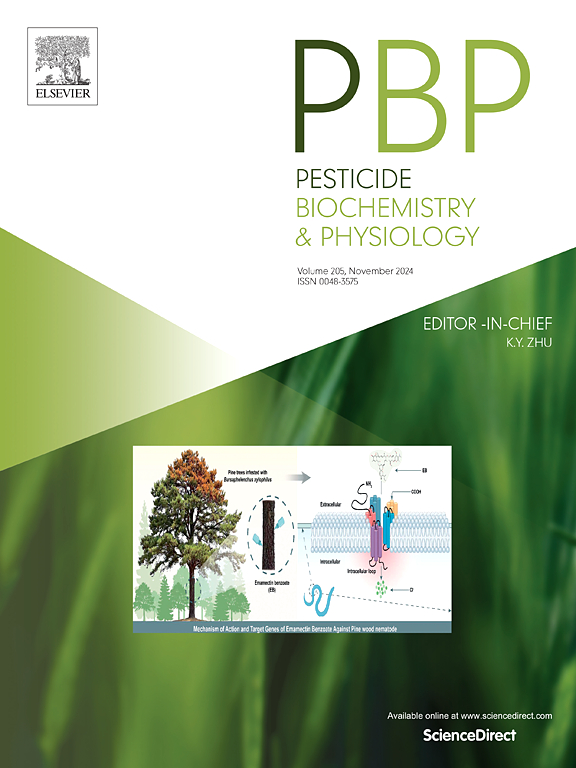CRISPR/Cas9 mediated knockout of laccase2 impairs cuticle tanning and pigmentation in the tobacco cutworm, Spodoptera litura
IF 4.2
1区 农林科学
Q2 BIOCHEMISTRY & MOLECULAR BIOLOGY
引用次数: 0
Abstract
Cuticle tanning is a vital physiological process in insects, mediated by the phenol oxidase Laccase2 (Lac2). To elucidate the functional role underlying cuticle formation in the economically important pest Spodoptera litura, SlitLac2 was functionally characterized in this study. The identified SlitLac2 encodes a protein containing conserved Cu-oxidase domains and a conserved cysteine-rich region, exhibiting high sequence simility to other lepidopteran Lac2 orthologs. Quantitative expression analysis revealed peak expression of SlitLac2 in 3rd instar larvae, with 251.45-, 25.06-, 34.43-, 341.04-, 31.67-, 158.04-, 5.68-, 228.43- and 668.31-fold higher expression levels than those in eggs, 1st, 2nd, 4th, 5th, 6th larvae, pupae, male adults and female adults, respectively. While tissue-specific profiling showed predominant expression in the epidermis, displaying 678.28-, 6.18-, 51.35-, 28.21- and 176.59-fold expression levels, compared to those in the hemolymph, head, malpighian tubule, fat body and midgut, respectively. Knockout of SlitLac2 severely impaired normal cuticle tanning of the 3rd, 4th, 5th, 6th instar larvae and pupae, ultimately leading to failure of adult eclosion. This study provides the first functional characterization of SlitLac2 in S. litura, establishing its critical role in cuticle formation and offering new insights into the molecular basis of insect development. Our findings identify SlitLac2 as a potential target for developing novel pest control strategies against this agriculturally significant species.
CRISPR/Cas9介导的漆酶2基因敲除会损害斜纹夜蛾(Spodoptera litura)的表皮鞣制和色素沉着
表皮鞣制是昆虫的一个重要生理过程,由酚氧化酶漆酶2 (Lac2)介导。为了阐明经济害虫斜纹夜蛾(Spodoptera litura)角质层形成的功能作用,本研究对SlitLac2进行了功能表征。所鉴定的SlitLac2编码一个含有保守的cu氧化酶结构域和一个保守的富含半胱氨酸的区域的蛋白,与其他鳞翅目Lac2同源物具有高度的序列相似性。定量表达分析显示,SlitLac2在3龄幼虫中的表达量最高,分别是卵、1、2、4、5、6龄幼虫、蛹、雄成虫和雌成虫的251.45-、25.06-、34.43-、341.04-、31.67-、158.04-、5.68-、228.43-和668.31倍。而在组织特异性分析中,表皮的表达量主要为血淋巴、头部、马氏小管、脂肪体和中肠的678.28倍、6.18倍、51.35倍、28.21倍和176.59倍。敲除SlitLac2严重破坏了3、4、5、6龄幼虫和蛹的正常表皮鞣制,最终导致成虫羽化失败。本研究首次对斜纹山梨中SlitLac2的功能进行了表征,确定了其在角质层形成中的关键作用,为昆虫发育的分子基础提供了新的见解。我们的研究结果确定了SlitLac2是开发针对这种农业上重要物种的新型害虫控制策略的潜在目标。
本文章由计算机程序翻译,如有差异,请以英文原文为准。
求助全文
约1分钟内获得全文
求助全文
来源期刊
CiteScore
7.00
自引率
8.50%
发文量
238
审稿时长
4.2 months
期刊介绍:
Pesticide Biochemistry and Physiology publishes original scientific articles pertaining to the mode of action of plant protection agents such as insecticides, fungicides, herbicides, and similar compounds, including nonlethal pest control agents, biosynthesis of pheromones, hormones, and plant resistance agents. Manuscripts may include a biochemical, physiological, or molecular study for an understanding of comparative toxicology or selective toxicity of both target and nontarget organisms. Particular interest will be given to studies on the molecular biology of pest control, toxicology, and pesticide resistance.
Research Areas Emphasized Include the Biochemistry and Physiology of:
• Comparative toxicity
• Mode of action
• Pathophysiology
• Plant growth regulators
• Resistance
• Other effects of pesticides on both parasites and hosts.

 求助内容:
求助内容: 应助结果提醒方式:
应助结果提醒方式:


